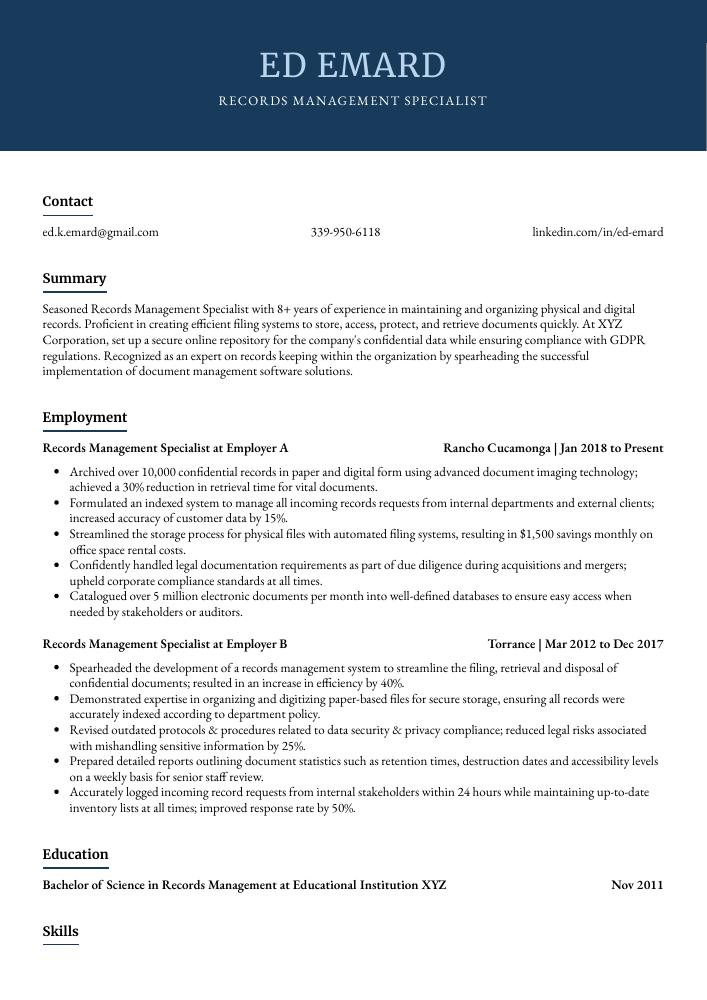Records Management Specialist Resume Guide
Records management specialists organize, store and retrieve records for their organization. They ensure that all documents are properly labeled and filed away as well as kept up to date with any changes or additions. Additionally, they monitor compliance of record-keeping regulations set by the government or other organizations.
Your expertise in records management is unparalleled. But hiring managers don’t know about your qualifications yet, so you need to create a resume that shows off your skills and experience.
This guide will walk you through the entire process of creating a top-notch resume. We first show you a complete example and then break down what each resume section should look like.
Table of Contents
The guide is divided into sections for your convenience. You can read it from beginning to end or use the table of contents below to jump to a specific part.
Records Management Specialist Resume Sample
Ed Emard
Records Management Specialist
[email protected]
339-950-6118
linkedin.com/in/ed-emard
Summary
Seasoned Records Management Specialist with 8+ years of experience in maintaining and organizing physical and digital records. Proficient in creating efficient filing systems to store, access, protect, and retrieve documents quickly. At XYZ Corporation, set up a secure online repository for the company’s confidential data while ensuring compliance with GDPR regulations. Recognized as an expert on records keeping within the organization by spearheading the successful implementation of document management software solutions.
Experience
Records Management Specialist, Employer A
Rancho Cucamonga, Jan 2018 – Present
- Archived over 10,000 confidential records in paper and digital form using advanced document imaging technology; achieved a 30% reduction in retrieval time for vital documents.
- Formulated an indexed system to manage all incoming records requests from internal departments and external clients; increased accuracy of customer data by 15%.
- Streamlined the storage process for physical files with automated filing systems, resulting in $1,500 savings monthly on office space rental costs.
- Confidently handled legal documentation requirements as part of due diligence during acquisitions and mergers; upheld corporate compliance standards at all times.
- Catalogued over 5 million electronic documents per month into well-defined databases to ensure easy access when needed by stakeholders or auditors.
Records Management Specialist, Employer B
Torrance, Mar 2012 – Dec 2017
- Spearheaded the development of a records management system to streamline the filing, retrieval and disposal of confidential documents; resulted in an increase in efficiency by 40%.
- Demonstrated expertise in organizing and digitizing paper-based files for secure storage, ensuring all records were accurately indexed according to department policy.
- Revised outdated protocols & procedures related to data security & privacy compliance; reduced legal risks associated with mishandling sensitive information by 25%.
- Prepared detailed reports outlining document statistics such as retention times, destruction dates and accessibility levels on a weekly basis for senior staff review.
- Accurately logged incoming record requests from internal stakeholders within 24 hours while maintaining up-to-date inventory lists at all times; improved response rate by 50%.
Skills
- Data Entry
- Database Management
- Record Keeping
- Document Management
- Process Improvement
- Compliance Management
- Information Security
- Data Analysis
- Microsoft Office Suite
Education
Bachelor of Science in Records Management
Educational Institution XYZ
Nov 2011
Certifications
Certified Records Manager (CRM)
Institute of Certified Records
May 2017
1. Summary / Objective
Your resume summary or objective should be a concise snapshot of your records management experience. It’s an opportunity to highlight the skills and qualifications that make you stand out from other candidates. For example, you could mention the software programs you are proficient in using, how many years of experience managing digital and physical records systems you have, or any awards or certifications related to record keeping that demonstrate your expertise.
Below are some resume summary examples:
Committed records management specialist with 7+ years of experience in managing and organizing records for various organizations. Adept at utilizing specialized software to create, maintain, and organize digital records efficiently. Experienced in handling confidential data as well as developing strategies for efficient record-keeping processes that meet regulatory compliance standards. At XYZ company, improved the organization’s filing system by 30%, resulting in easier access to important documents.
Determined records management specialist with 5+ years of experience in maintaining, organizing and updating records. Expertise in designing filing systems to maximize workflow efficiency while ensuring accuracy, security, compliance and confidentiality. At XYZ Inc., managed the implementation of new record keeping system that resulted in a 38% increase in productivity. Dedicated to providing excellent customer service and support through effective records management solutions.
Professional Records Management Specialist with 8+ years of experience in the records management field. Skilled at developing and implementing effective policies, procedures, and standards for paper-based filing systems as well as electronic document storage solutions. Seeking to join ABC Records Team to utilize expertise in database design, data entry accuracy, compliance enforcement, and customer service support for improved organizational efficiency.
Reliable records management specialist with 10+ years of experience in a fast-paced environment. Proven ability to maintain accurate records and ensure compliance with organizational policies and regulations. Skilled at managing databases, creating reports, and providing customer service support for internal staff members. At XYZ Corporation, administered the document retention program that resulted in an 8% reduction in legal risk exposure.
Diligent records management specialist with 8+ years of experience managing and maintaining records systems for large organizations. Proven track record in streamlining processes, instituting best practices, and creating data-driven strategies to ensure the accuracy of digital records. Seeking to join ABC Company to use my expertise in developing efficient filing methods that will promote organizational compliance.
Proficient Records Management Specialist with 7+ years of experience in developing and executing records management strategies. Highly skilled in creating efficient filing systems, digitizing paper files, and managing access to confidential information. Seeking to join ABC Company as a Records Management Specialist to leverage my expertise and knowledge of retention regulations for the company’s benefit.
Dependable records management specialist with over 10 years of experience in secure document storage, distribution, and retrieval. Recent successes include streamlining an antiquated filing system that saved ABC Company 15% on annual costs. Looking to join the team at XYZ Corporation as a records management specialist to maintain efficient access control systems and ensure compliance standards are met.
Well-rounded records management specialist with 5+ years of experience in creating, organizing and maintaining records. Proven success in developing automated systems to improve accuracy and efficiency while reducing human error by 40%. Seeking to join ABC Company as a Records Management Specialist where I can leverage my expertise in data analysis, problem-solving and documentation.
2. Experience / Employment
In the experience section, you should list your employment history in reverse chronological order. This means that your most recent job is listed first.
When writing out what you did at each role, use bullet points to make it easier for the reader to digest the information quickly. You want to provide detail on what you did and any quantifiable results obtained from your efforts.
For example, instead of saying “Organized records,” you could say “Developed a filing system for hard copy documents which resulted in an 80% reduction in retrieval time.”
To write effective bullet points, begin with a strong verb or adverb. Industry specific verbs to use are:
- Organized
- Catalogued
- Archived
- Digitized
- Monitored
- Updated
- Retrieved
- Processed
- Secured
- Disposed
- Reconciled
- Assessed
- Analyzed
- Evaluated
Other general verbs you can use are:
- Achieved
- Advised
- Compiled
- Coordinated
- Demonstrated
- Developed
- Expedited
- Facilitated
- Formulated
- Improved
- Introduced
- Mentored
- Optimized
- Participated
- Prepared
- Presented
- Reduced
- Reorganized
- Represented
- Revised
- Spearheaded
- Streamlined
- Structured
- Utilized
Below are some example bullet points:
- Reorganized records database of 500+ documents, reducing retrieval time by 40% and increasing storage efficiency.
- Independently reviewed hardcopy forms for accurate completion and data entry accuracy; identified 10 errors in the document archive which were rectified on-the-spot.
- Compiled a monthly report outlining all records management activity with respect to new additions, deletions & modifications; presented findings to senior management team resulting in improved compliance standards across the organization.
- Utilized advanced scanning technology to digitize paper files while maintaining highest security protocols during archiving process; successfully stored over 200 confidential documents electronically with zero breach incidents reported since implementation date.
- Organized physical filing systems consisting of more than 50 folders using established labeling system for easy identification and retrieval; saved employees an average of 3 hours per week with improved access times.
- Developed and implemented a comprehensive records management system, streamlining the process of collecting and organizing physical and digital documents to improve efficiency by 24%.
- Digitized hundreds of paper-based files into an electronic database, saving up to 2 hours per employee in searching for specific documents; reduced storage costs by 20% within 6 months.
- Successfully trained over 10 personnel on proper document filing procedures and best practices while maintaining accuracy across all departments’ records systems.
- Reduced manual errors related to misfiled or lost paperwork by 30%, resulting in cost savings throughout the organization due to fewer inaccuracies during audits & routine document checks.
- Monitored compliance with state regulations regarding documentation retention policies, ensuring that sensitive information was securely stored at all times.
- Improved records management operations by 15%, streamlining filing systems and implementing new digital storage solutions.
- Presented innovative methods for the classification of documents to a cross-functional team, resulting in an increase of productivity by 10%.
- Reliably maintained confidential records within secure databases while protecting their confidentiality per company policies; improved security protocols to reduce data breaches incidents by 25%.
- Analyzed current recordkeeping processes and identified areas for improvement, saving 20% on operational costs over 6 months period.
- Advised colleagues regarding complex information governance issues such as privacy legislation compliance and destruction/retention requirements; provided training sessions on related topics with positive feedback from attendees.
- Secured and maintained accurate records of over 500 external contracts, ensuring compliance with all federal and state regulations; reduced paperwork processing time by 20%.
- Introduced an automated system for managing records, resulting in an improved filing accuracy rate of more than 90%, while saving up to $30,000 annually on paper costs.
- Represented the company at industry meetings related to record management best practices as well as legal requirements; created new processes that increased document security levels by 50%.
- Evaluated existing policies and procedures regarding data retention schedules and archiving methods, suggesting improvements which resulted in a 25% reduction in storage space needs without compromising information integrity or accessibility.
- Diligently monitored internal systems for potential risks associated with improper handling or destruction of confidential documents, completing audits every 3 months to ensure adherence to established standards & protocols.
- Competently organized and managed confidential records of over 500 customers while ensuring accuracy, completeness and compliance with company policies; reduced filing time by 20%.
- Updated customer databases regularly to reflect changes in services or contact information; sorted documents into appropriate categories for easier retrieval.
- Achieved an average filing accuracy rate of 95% within a month due to efficient data entry skills and attention-to-detail when entering information into the system.
- Processed up to 100 requests for access to sensitive customer files per day, verifying user credentials before granting access authorization as required by law & regulations.
- Coordinated with other departments on proper document storage protocol while training staff members on record keeping procedures; improved overall efficiency by 15%.
- Actively maintained and updated over 50,000 records in the company’s digital filing system; streamlined processes to reduce search time by 25%.
- Disposed of outdated documents according to legal protocols while ensuring that all necessary files were securely retained; reduced storage costs by $1,500 per month.
- Mentored five new Records Management Specialists on best practices for data management, document control systems and record retention policies.
- Expedited documentation procedures which resulted in a 10% increase in customer service satisfaction ratings within three months period of implementation.
- Structured an organized filing system for over 200 client accounts; enabled quick retrieval of information with 98% accuracy rate each query received from clients or internal users.
- Optimized records management systems by introducing innovative processes that reduced data entry time by 25% and improved overall accuracy.
- Retrieved, filed and organized confidential client records within the framework of applicable security procedures; successfully maintained 100% compliance with GDPR regulations.
- Participated in a team project to develop an automated filing system for all paper-based documents which eliminated manual document search times from 24 hours to 1 hour.
- Facilitated collaboration between departments on record retention policies, resulting in 7 new guidelines established that optimized storage capacity while preserving organizational integrity & privacy standards across the board.
- Resourcefully created user guides and training videos for staff members on best practices related to electronic archiving of documents; increased usage rate by 50%.
3. Skills
The skillset employers require in an employee will likely vary, either slightly or significantly; skimming through their job adverts is the best way to determine what each is looking for. One organization might be seeking a records management specialist with experience in database design, while another might require the candidate to have knowledge of data analysis.
It is important to tailor your resume skills section according to each job you are applying for; this way, it will pass through any applicant tracking systems used by employers and reach human eyes.
In addition to listing these qualifications here, you should also discuss them further in other sections such as the summary or work history areas.
Below is a list of common skills & terms:
- Compliance Management
- Data Analysis
- Data Entry
- Database Management
- Document Management
- Information Security
- Microsoft Office Suite
- Process Improvement
- Record Keeping
4. Education
Adding an education section to your resume will depend on how far along you are in your career. If you recently graduated and have no experience, mention your education below the objective statement. However, if you already have a significant amount of work experience to showcase, omitting an education section might be best.
If including an education section is necessary for the job application process, try to list courses and subjects related to records management that would show recruiters why you’re qualified for this role.
Bachelor of Science in Records Management
Educational Institution XYZ
Nov 2011
5. Certifications
Certifications are a great way to demonstrate your expertise in a particular field. They can be used to show potential employers that you have the necessary skills and knowledge for the job, as well as having taken extra steps to stay up-to-date with industry trends.
If you are applying for a position which requires specific certifications or qualifications, make sure that these are included prominently on your resume so they don’t go unnoticed by recruiters.
Certified Records Manager (CRM)
Institute of Certified Records
May 2017
6. Contact Info
Your name should be the first thing a reader sees when viewing your resume, so ensure its positioning is prominent. Your phone number should be written in the most commonly used format in your country/city/state, and your email address should be professional.
You can also choose to include a link to your LinkedIn profile, personal website, or other online platforms relevant to your industry.
Finally, name your resume file appropriately to help hiring managers; for Ed Emard, this would be Ed-Emard-resume.pdf or Ed-Emard-resume.docx.
7. Cover Letter
Submitting a cover letter along with your resume is a great way to stand out from other applicants and make a lasting impression. Cover letters are made up of 2-4 brief paragraphs that provide more detail about who you are, what skills and experiences you have, and why you’re the best candidate for the job.
Although cover letters aren’t always required when applying for jobs, writing one can give recruiters an additional insight into your qualifications as well as allowing them to get to know you better on a personal level.
Below is an example cover letter:
Dear Bailee,
I am writing to apply for the position of Records Management Specialist at XYZ Corporation. With more than 10 years of experience in records management and a strong commitment to accuracy and efficiency, I am confident I can make a positive contribution to your team.
In my current role as Records Management Specialist at ABC Corporation, I manage all aspects of records management for the organization, including storage, retrieval, destruction, and archiving. I have developed efficient processes for managing physical and electronic records that meet all legal requirements and maximize space utilization. In addition, I have created training materials and provided training on records management procedures to employees throughout the organization.
Through my work experience, I have gained strong attention to detail and organizational skills that would benefit XYZ Corporation. My knowledge of best practices in records management would be an asset in developing or improving systems at your organization. In addition, my excellent communication skills would be beneficial in providing training on records management procedures to employees.
I look forward to discussing how my experience could benefit XYZ Corporation as your Records Management Specialist during an interview at your earliest convenience. Thank you for your time and consideration; please do not hesitate to contact me if you have any questions about my qualifications or application materials.
Sincerely,
Ed
Records Management Specialist Resume Templates
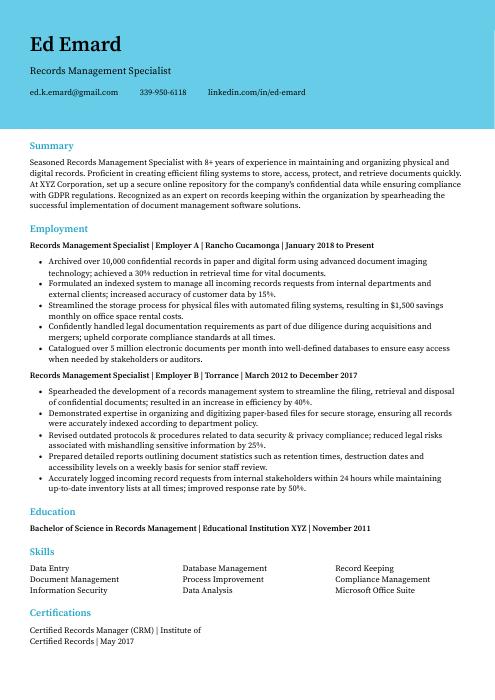 Dugong
Dugong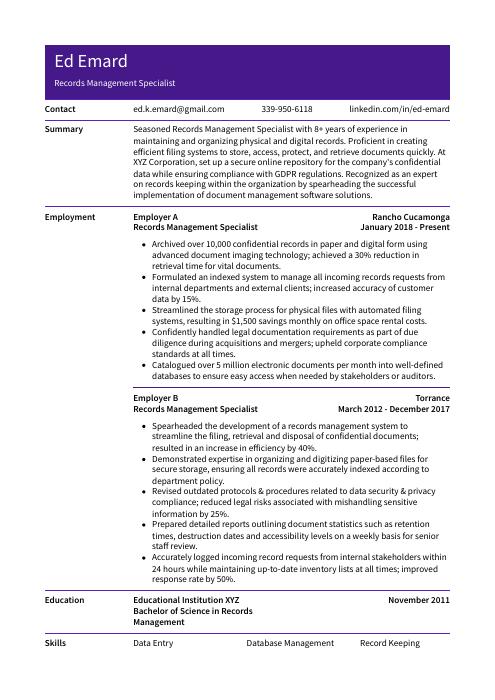 Pika
Pika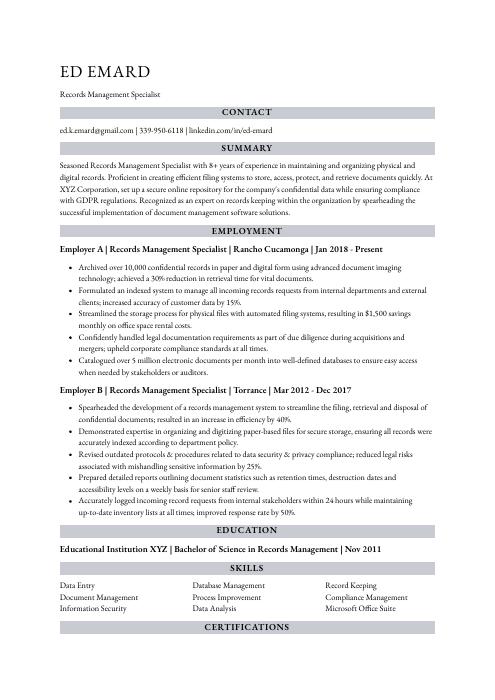 Numbat
Numbat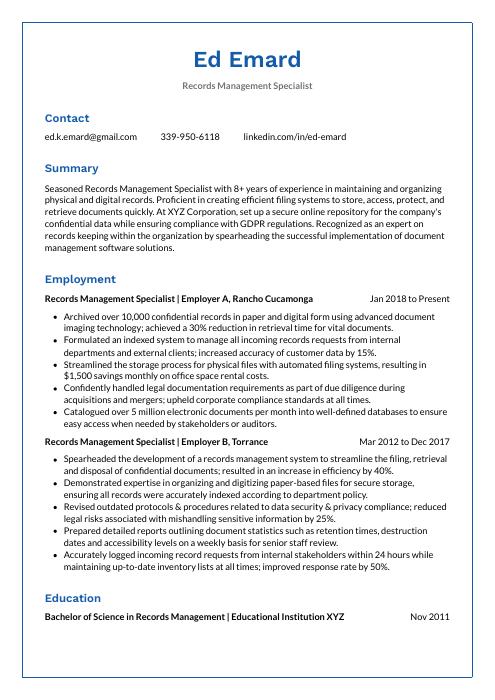 Markhor
Markhor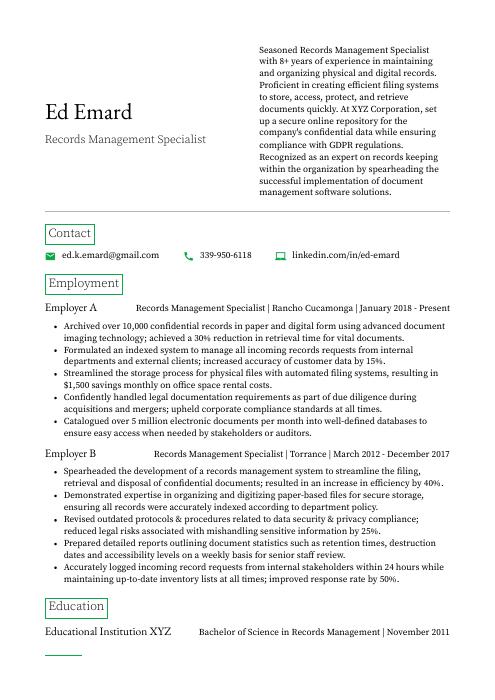 Quokka
Quokka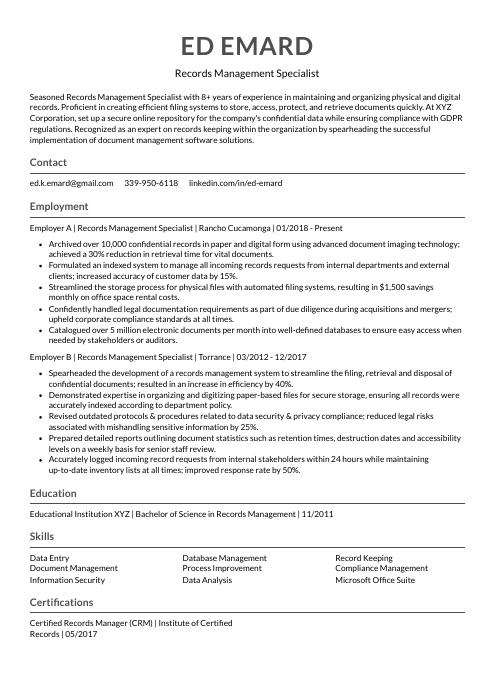 Indri
Indri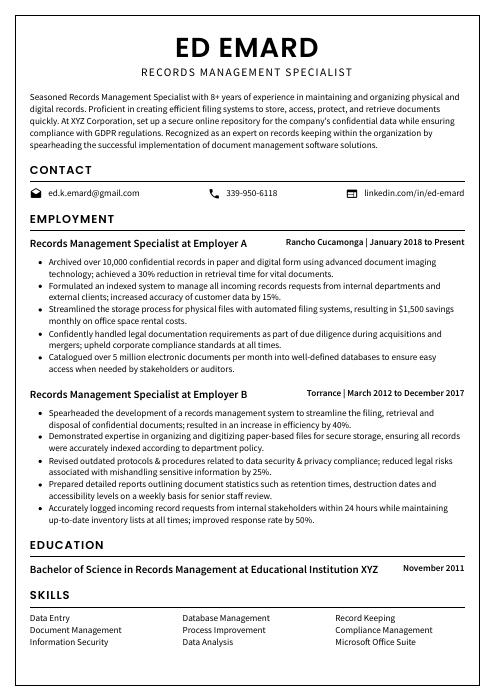 Cormorant
Cormorant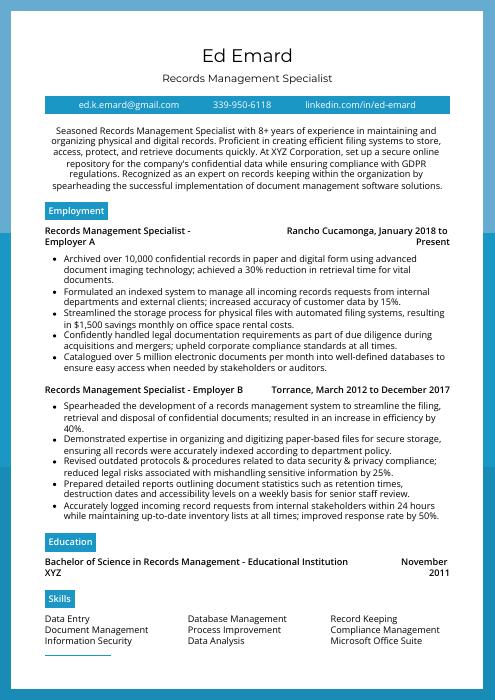 Rhea
Rhea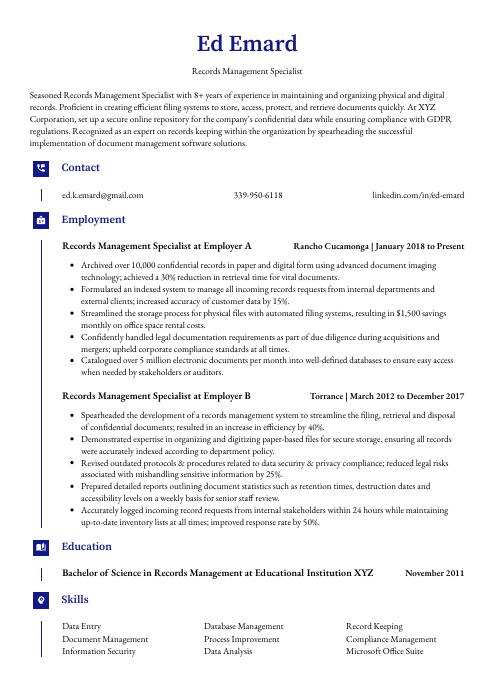 Gharial
Gharial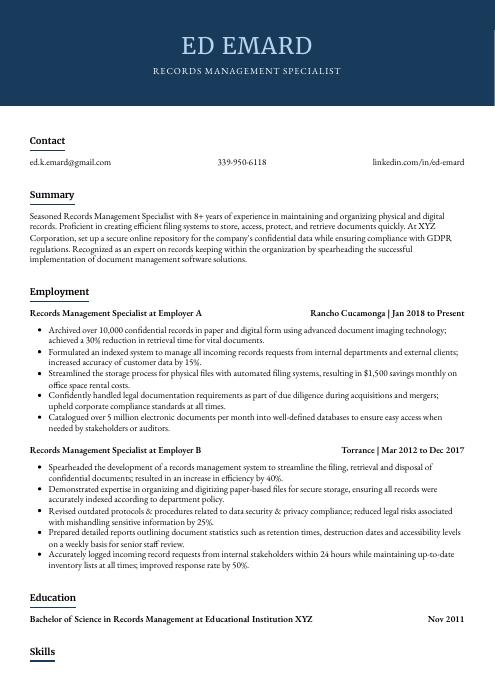 Bonobo
Bonobo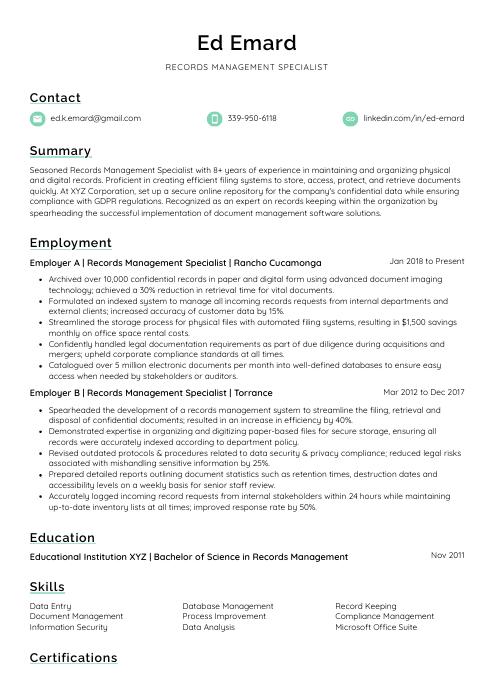 Lorikeet
Lorikeet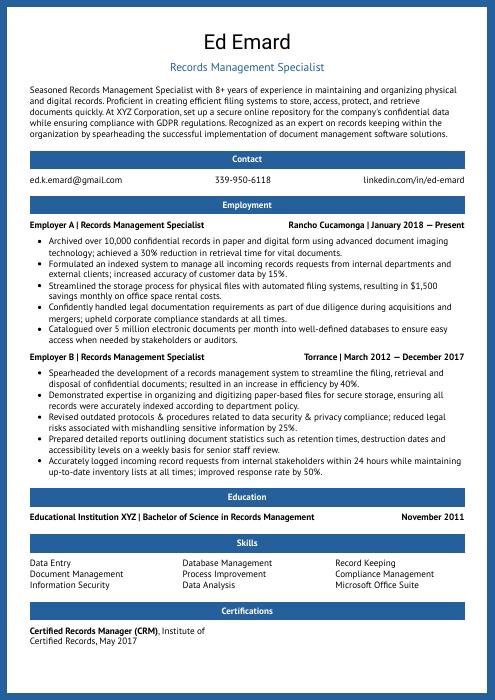 Ocelot
Ocelot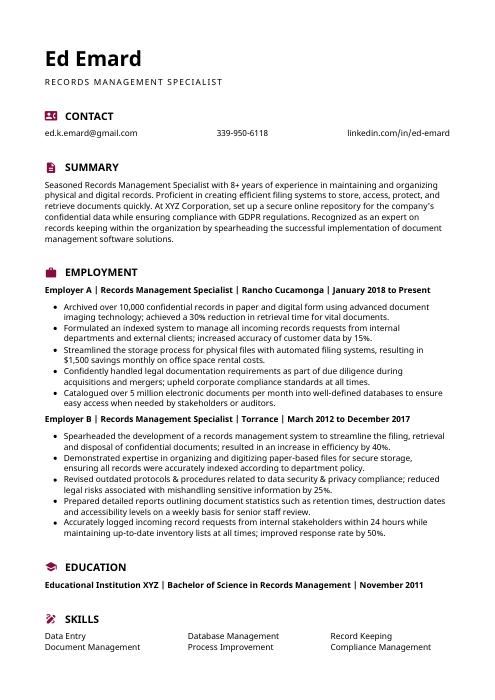 Hoopoe
Hoopoe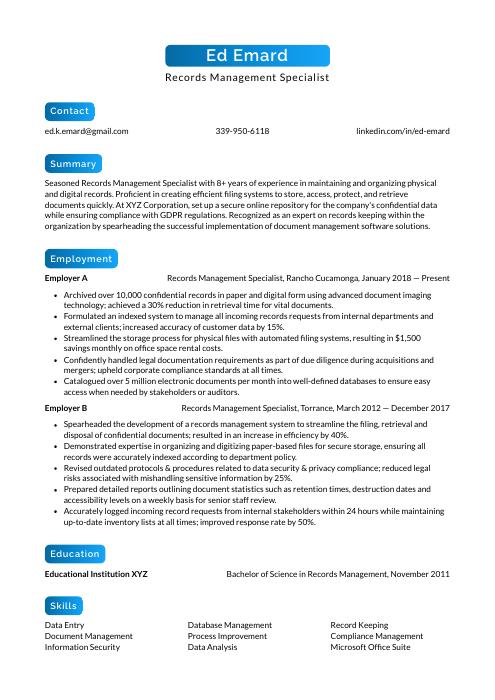 Kinkajou
Kinkajou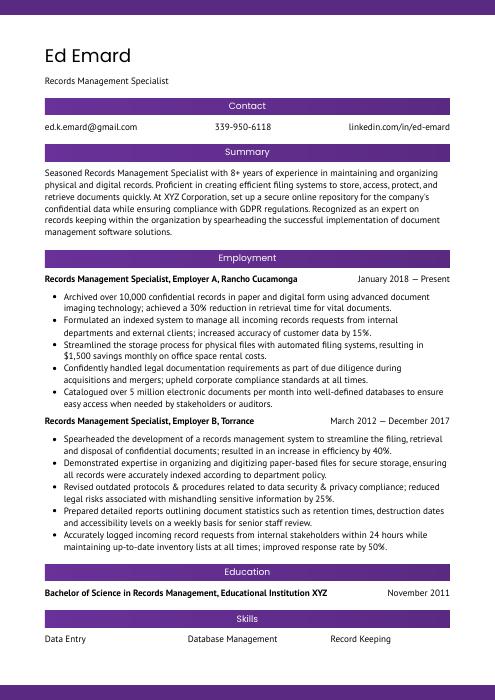 Jerboa
Jerboa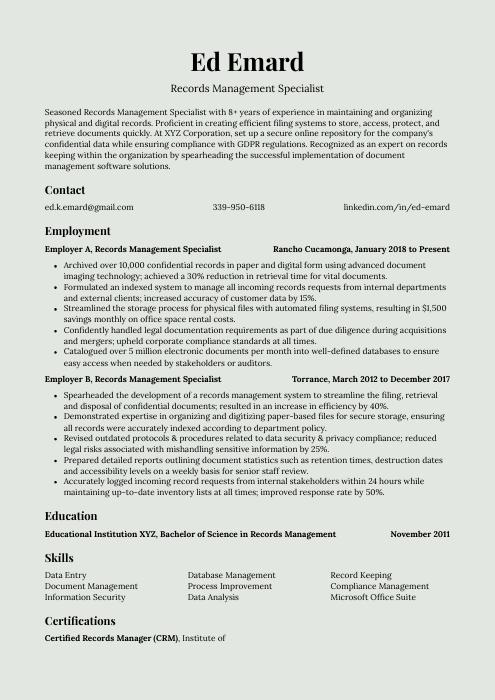 Saola
Saola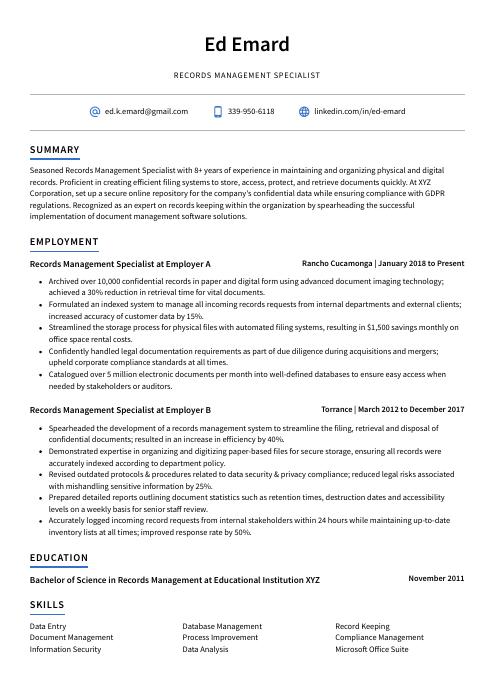 Axolotl
Axolotl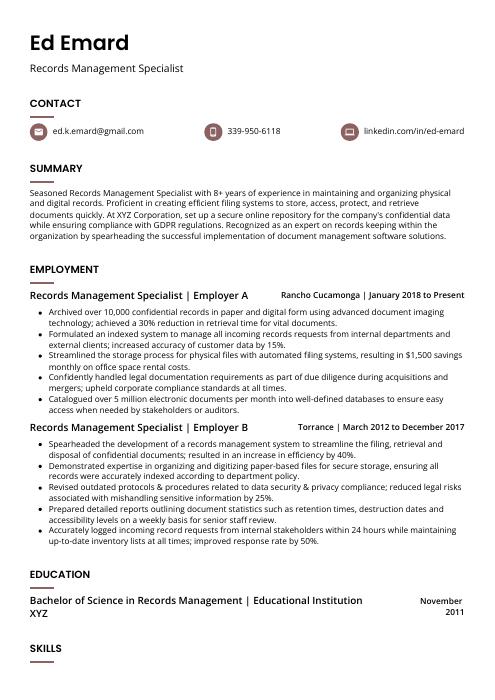 Fossa
Fossa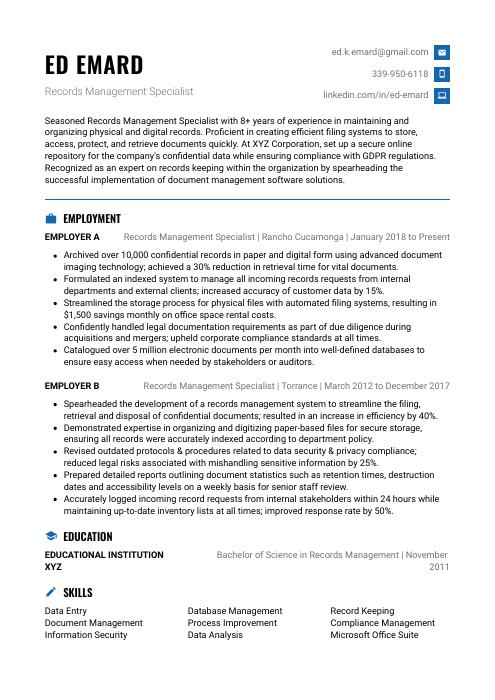 Echidna
Echidna Rezjumei
Rezjumei
